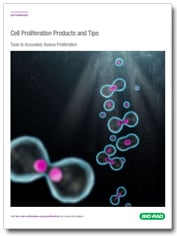Protocol: Determining Optimum Length of Incubation, Plating Density

- On This Page
- Overview
Overview
The two variables which most affect the response of cells to alamarBlue are length of incubation time and number of cells plated. It is recommended that the plating density and incubation time be determined for each cell line using the following procedure:
- Harvest cells which are in log phase growth stage and determine cell count. Plate cells at various densities, above and below the cell density expected to be used.
- Aseptically add alamarBlue in an amount equal to 10% of the volume in the well.
- Return plates to incubator. Remove the plate and measure fluorescence/absorbance each hour following plating for the first 6-8 hr. It is also recommended that the plates remain in incubation overnight and measurements be made the following day at 24 hr. Two kinds of information can be obtained from this data:
(i) for any given incubation time selected, the range in cell density relating cell number to alamarBlue reduction can be determined by a linear response.
(ii) for any given cell density selected, the incubation time can be determined as the time taken for the control cells to turn the indicator from the oxidized (blue) form to the fully reduced (red) form.
- Measure absorbance at a wavelength of 570 nm and 600 nm; or measure fluorescence with an excitation wavelength at 530-560 nm and emission wavelength at 590 nm.
- Calculate the percentage reduction of alamarBlue at each cell density or incubation period.
a. Equation 1 calculates percentage reduction of alamarBlue using absorbance
Percentage reduction of alamarBlue (equation 1) |
= |
(O2 x A1) - (O1 x A2) (R1 x N2) - (R2 x N1) |
x100 |
|---|
Where:
- O1 = molar extinction coefficient (E) of oxidized alamarBlue (blue) at 570 nm*
- O2 = E of oxidized alamarBlue at 600 nm*
- R1 = E of reduced alamarBlue (red) at 570 nm
- R2 = E of reduced alamarBlue at 600 nm
- A1 = absorbance of test wells at 570 nm
- A2 = absorbance of test wells at 600 nm
- N1 = absorbance of negative control well (media plus alamarBlue but no cells) at 570 nm
- N2 = absorbance of negative control well (media plus alamarBlue but no cells) at 600 nm
* Only one appropriate substitute wavelength may be used.
Example data:
- O1 = 570 nm O2 = 600 nm
- O1 = 80586 (see table in general method for oxidation coefficients)
- O2 = 117216
- R1 = 155677
- R2 = 14652
- A1 = 0.61 observed absorbance reading for test well
- A2 = 0.42 observed absorbance reading for test well
- N1 = 0.44 observed absorbance reading for negative control well
- N2 = 0.64 observed absorbance reading for negative control well
To calculate percent reduced using equation 1:
| Percentage | reduction = |
(117,216 x 0.61) - (80,586 x 0.42)
(155,677 x 0.64) - (14,652 x 0.44)
|
x 100 |
| = |
71,502 - 33,846
99,633 - 6.446
|
x 100 | |
| = | 0.404 | x 100 | |
| = | 40% |
| Absorbance 560 nm | Absorbance 605 nm | |
|---|---|---|
| 10% alamarBlue in 100 µl media | 0.474 | 0.815 |
| 100 µl media | 0.082 | 0.037 |
| Test well after 60 min incubation | 0.639 | 0.889 |
| Test well after 120 min incubation | 0.797 | 0.893 |
Molar extinction coefficients for alamarBlue at different wavelengths
b) To calculate percentage reduction of alamarBlue using fluorescence, use equation 2:
Percentage reduction of alamarBlue (equation 2) |
= |
FI 590 of test agent - FI 590 untreated control FI 590 of 100% reduced alamarBlue - FI 590 untreated control |
x100 |
|---|
Where: FI 590 = Fluorescent Intensity at 590 nm emission (560 nm excitation).
Example data:
- Media RPMI 1640. One sample autoclaved for 15 min to produce reduced form (100% reduced alamarBlue).
- Fluorescence 100% reduced alamarBlue = 58796
- Fluorescence of uninoculated broth (untreated control) = 6472
- Fluorescence of treated sample = 25670
|
Percentage reduction of alamarBlue
|
=
|
25670 - 6472
58796 - 6472
|
x 100
|
|
|
=
|
36.7%
|
- Plot a graph of percentage reduction of alamarBlue at each cell density or incubation period.
a) For experiments to determine optimum cell density, plot log of cell density on the x axis, and percentage reduction on the y axis.
b) For experiments to determine the optimum incubation time, plot the number of hours on the x axis, and the percentage reduction on the y axis.
c) Use the graphs to determine optimum cell density or incubation period.
Protocols for alamarBlue



